The 2022 Outlook on Data and Technology: A Year of Herding Cats and Black Holes
Is your marketing technology stack “more complex than a black hole”?
Would you say getting your entire organization behind improving data orchestration is like herding cats?
If so, you are not alone. Anteriad knows because we asked marketers about the biggest challenges faced — and opportunities available — in their data capabilities and marketing technology stacks.
The good news is, more data is available today than ever. The key to turning that data into a lead pipeline and eventual revenue is having the capability to clean, organize, and break it down into usable insights. In other words, information collection is only a part of the data journey. Making your data truly valuable requires thoughtful planning and processes. And with a constantly evolving technology landscape — and changes in market trends — getting it right is a moving target for B2B marketers.
Anteriad sought to learn how marketers are thinking about, using, and planning for the future of data and martech. In partnership with the research firm Ascend2, we surveyed 370 marketing leaders at mid-market and enterprise companies in the United States and the United Kingdom.
Key Highlights
Having a comprehensive strategy pays off
Two-thirds of marketers report their organizations do not have a comprehensive data strategy in place to inform marketing, but those who do see significantly more success from campaigns, are better able to derive actionable insights from their data, and have a more positive outlook on achieving goals next year.
Data that flows makes revenue grow
Though only a quarter of organizations report having fully integrated data, those who do saw more revenue growth last year and feel more confident in the security and compliance of the data they use.
What’s achievable in the year ahead?
Some marketers are optimistic about what’s ahead; 29% anticipate an increased ability to meet goals/KPIs in the coming year. What makes these sunny folks different from the rest? They are more likely to have a comprehensive data strategy, are executing account-based marketing (ABM) programs, and feel more confident in their data privacy and security compliance.
The Impact of a Comprehensive Data Strategy
In the coming year, the majority (56%) of respondents will be focused equally on driving revenue via net-new logos and upselling/cross-selling existing customers, while 20% are focusing mainly on net-new and 24% on expanding/upselling existing accounts.
Having a comprehensive data strategy is critical for both marketing and sales, no matter which set of customers you are focused on. Yet, there is a lot of room for growth here – only one-third of marketers have implemented one.
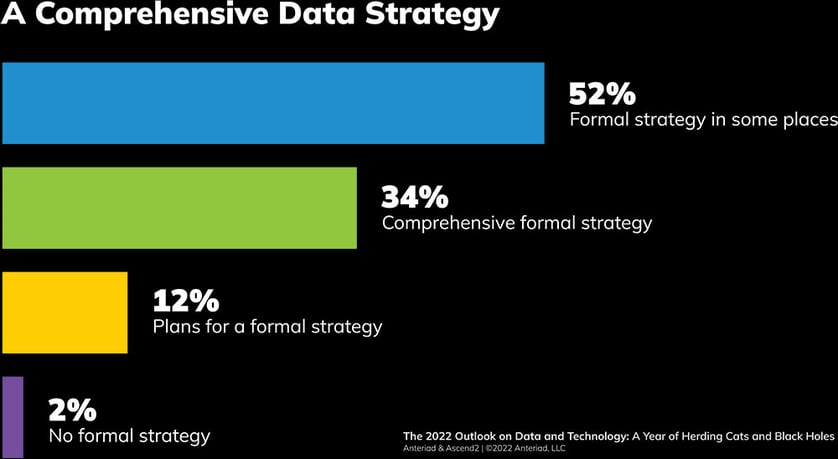
Having a comprehensive strategy pays off. Those businesses that have one in place are 3.6 times more likely to report excellence in deriving actionable insight from data compared to those that do not (54% versus 15%). This group also reports less time to get a campaign in market and experiences significantly more success from their campaigns overall.
Where B2B Marketers Face the Biggest Challenges
Overall, marketers say the most challenging area to execute B2B programs/campaigns is design. Mid-market companies report having more trouble with analytics, while enterprises struggle with the delivery of their programs and campaigns.
These areas also represent the largest deviation in responses between mid-market and enterprise companies; analytics represented a significant challenge for 40% of the mid market, compared to only 27% for enterprises. Conversely, 40% of enterprises cited delivery as a major issue, while only 30% of mid-market companies struggle with it.

As organizations increase in size and complexity, launching any initiative becomes more of a challenge as the number of decision makers increases.
Analytics expertise is hard to come by, so mid-market companies may have trouble finding the talent to fill the roles.
The Importance of a High-Functioning Tech Stack
Technology software and solutions are integral to a comprehensive marketing and sales data strategy – and there is a dizzying array of options to collect, orchestrate, and utilize data. It seems we as marketers are continually evaluating new tools and deciding whether we’re making the most of the ones we have!
The Existing Martech Stack
When asked what tools make up their martech stack – specifically, tools to store and manage data directly related to the customer journey and marketing activities – it’s no surprise many marketing professionals cite their Customer Relationship Management (CRM) first. CRM solutions have become critical to an integrated marketing-sales pipeline.
As well, while the demise of the Data Management Platform (DMP) was expected, the extension of Google Chrome third-party cookies at least until 2024 means that tech remains a valuable part of the stack for more than a quarter of respondents.
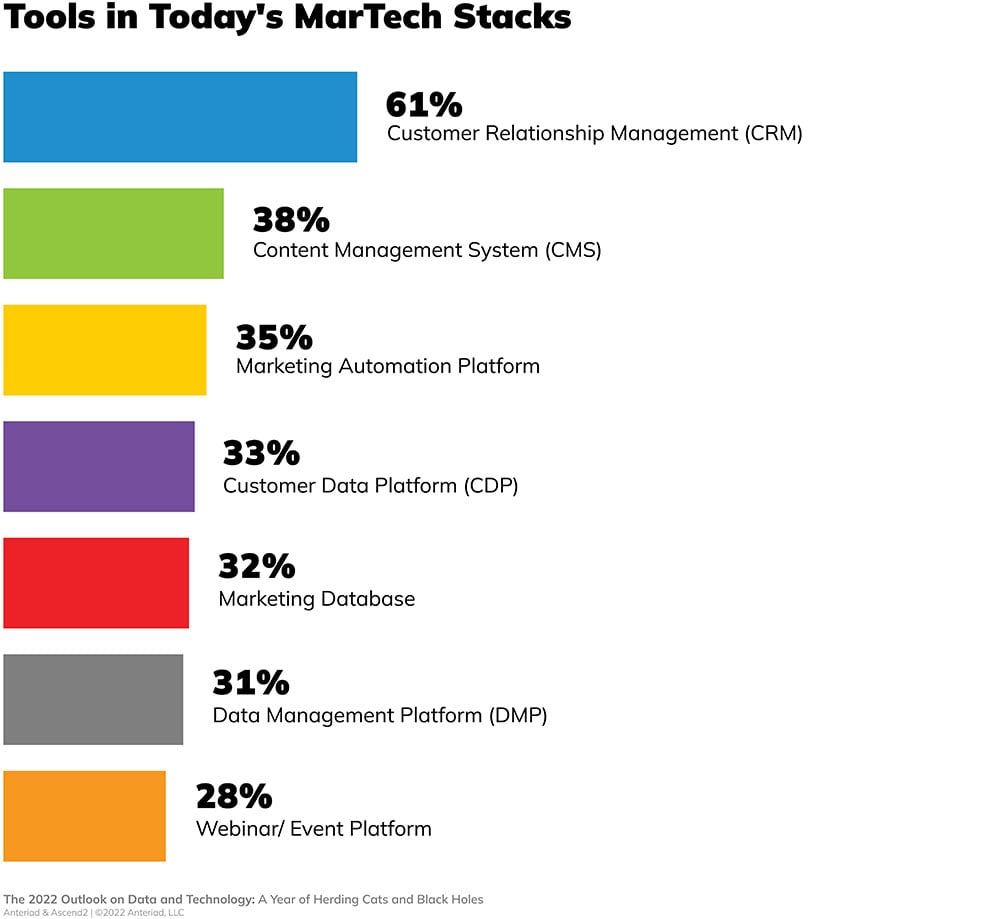
Technology Challenges
When asked about the current state of their technology, one in five marketers say their current martech stack is more complex than a black hole. Interestingly, marketers in the United Kingdom were twice as likely to have that opinion than those in the United States (30% vs. 14%).
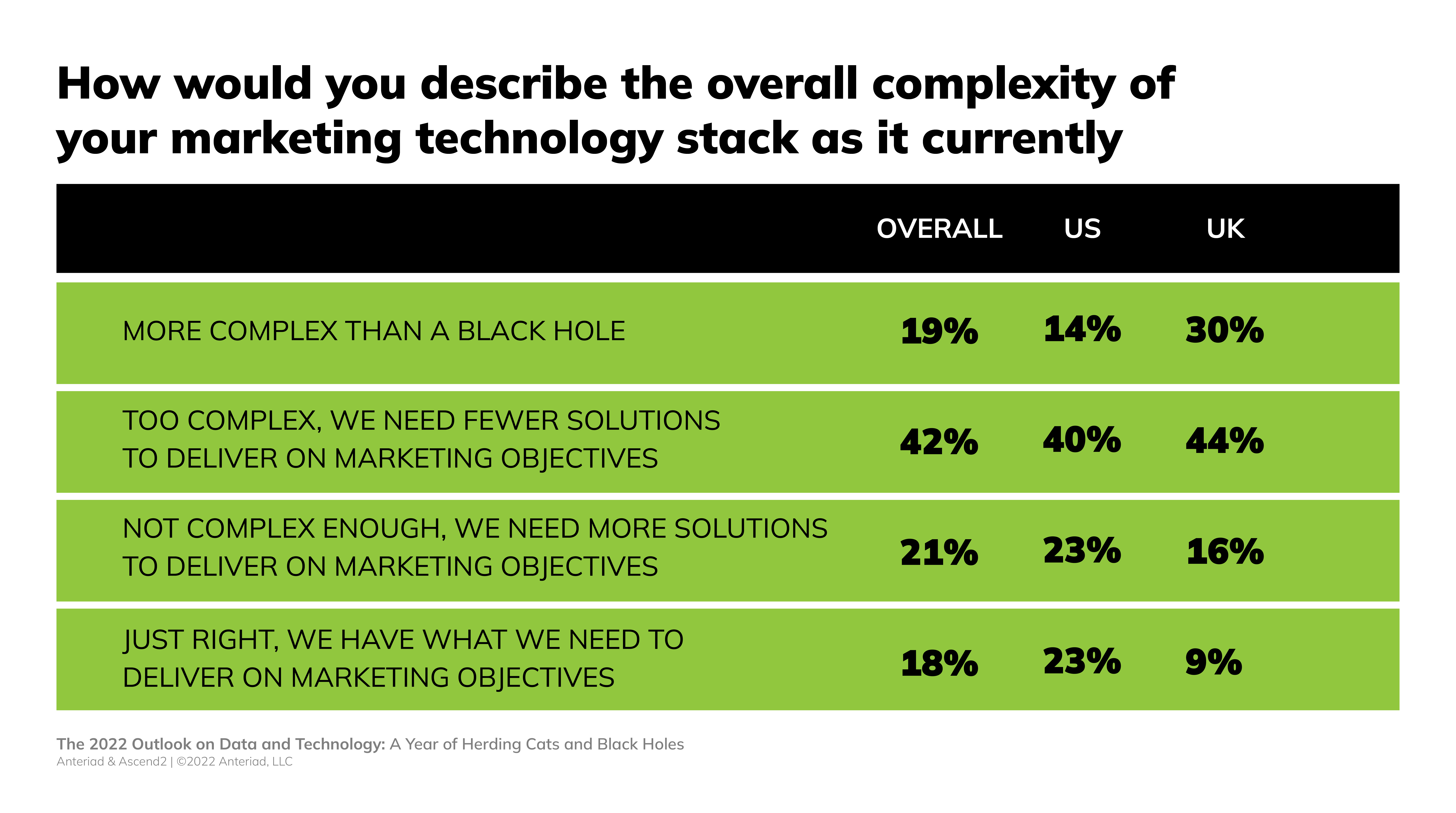
According to the respondents, the stack is growing to address numerous challenges they face with their data.
Notably, 92% of marketers in the United Kingdom anticipate an increase, while 70% in the United States are looking at a larger budget. Almost all (93%) agree that replacing, updating, or consolidating tools in their current technology stack would make it function more efficiently.
The problems marketing teams seek to address with new technology investments include:
Nearly 85% of those surveyed expect an increased investment in technology that supports marketing and sales in the coming year.

Collecting Data that Matters
With the availability of sophisticated solutions, data collection sounds simple, but in practice, it can be a complex and multilayered undertaking.
First, there is the breadth of data that can be collected (demographic; firmographic; technographic; intent; etc.) as part of an overall strategy to drive marketing decisions.
Second, a variety of methods exist to collect the data (surveys, online behavior, web registration forms, etc.).
Finally, there is the question of where marketers source their data.
Where is Data Coming From?
The vast majority of respondents report working with between one and ten third-party data sources. In that group, 46% say they use between one and five sources and another 32% are using between five and ten sources (78% total). Only about 15% of those surveyed say they work with more than 10 third-party sources.
It turns out that having more sources does not necessarily improve marketers’ ability to target the right audience or improve customer experience (CX) — those who use more than six third-party sources actually reported 10% less targeting benefit and 13% less CX benefit.
If you are in the group using more sources, you should forensically analyze each source to understand which ones are providing impactful data — such as intent data — that can actually improve the buying and customer experience.
Mirroring the third-party data responses, 75% of marketers report being aware of between one and ten internal first-party data sources (45% say between one and five, while 30% say six to ten) and 20% have more than ten. (10% of respondents were unsure.)
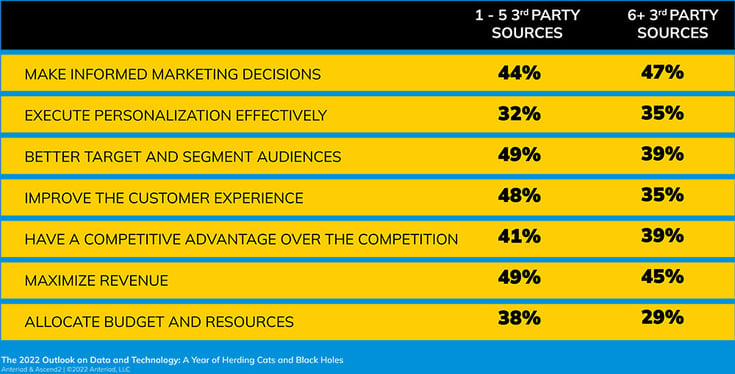
When it comes to making effective use of data, less than half of the respondents feel confident in the ability to fully utilize what they are collecting.
A Focus on Intent
Marketers have a positive outlook on the value of intent data. Companies that plan to increase their use of intent data in the coming year feel significantly more confident about achieving their marketing and business goals.
Among the group that reports using more intent data in the coming year, 90% feel confident about success. For the groups that don’t have plans to increase their use of intent data — or don’t leverage intent data at all — only 70% are confident in success.
In other words, marketers who plan to “significantly” expand their use of intent data next year report they are more than twice as likely to meet their goals, compared to marketers who are keeping their intent data use the same or don’t use it at all (39% for the former group, vs. 15% for the latter).
Putting All the Data Together
Data orchestration is closely related to an organization’s martech stack, so, not surprisingly, those respondents who feel confident in their ability to organize their data are also confident in their technology tools.
Only one-third of marketers surveyed report having a marketing database in place to store and manage marketing data. But among that group, one-half feel they are collecting the right data to gain a competitive advantage in the marketplace (compared to just 34% of those who don’t use a marketing database).
Key to successful data orchestration is having an integrated martech stack that automates the flow of data. However, only 23% of marketers have fully integrated data that flows from one system to another without manual input. The correlation between integration and success is clear.
72% of companies with fully integrated data saw more revenue growth last year, compared to 53% of those who are not fully integrated.
A fully integrated martech stack also boosts overall confidence in the business’ data privacy and cybersecurity posture. Today, most marketers are not extremely confident in their data privacy compliance and security (43%). This confidence increases significantly for those who have fully integrated data. Nearly three-quarters (72%) of this group feel extremely confident in their data privacy compliance and security.
Despite the clear advantages to data integration, many businesses still have a way to go. Almost 38% of marketers admit that getting their team interested in a project to improve data orchestration is like “herding cats,” according to the survey.
Data Normalization
Most marketers agree data normalization is a fundamental part of successful orchestration. However, despite recognizing the challenges for proper data hygiene, there is an indisputable divide along the hierarchy of many organizations.
Leadership in particular may be slow to recognize how great a challenge that cross-organizational data normalization can be. The lack of normalization of data across systems is the top challenge for directors and managers, but it doesn’t even make the top-three challenges for executives. Nearly 40% of directors and managers identify data normalization as an issue. For vice presidents and above, the number is less than 30%.
Data normalization is essential to deriving actionable insights. Less than one-third (29%) of those surveyed report that data is normalized extensively across their organization. But those with extensively normalized data are almost six times more likely to have an excellent ability to derive actionable insights from the data they collect: 67% of those with extensively normalized data compared to just 12% of all others.
More than one-third (37%) of respondents are cleaning, appending, or otherwise updating their marketing data in real time. Another 31% address data hygiene monthly.
Putting Data into Action
Data only has value if it can be used to make sound marketing decisions and drive successful efforts. Excellence in data utilization drives revenue.
Marketers who rate their ability to derive actionable insights from the data they collect as “excellent” or “very good” are nearly three times more likely to have increased revenue last year than those who rate this ability as simply “average.”
On the other hand, less than half (46%) report they are, in fact, collecting the right data to make informed marketing decisions and maximize revenue. Even fewer (43%) say they are able to better target and segment audiences and improve the customer experience with the data they are collecting.
In the face of these data challenges, marketers are taking action. When asked about priorities for improving the utilization of data in the year ahead, the top responses were:

Among C-suite respondents, updating the technology stack is the number one priority (48%). For VPs, adopting a data strategy is the top response (56%). For managers and directors, the number one answer is centralizing/unifying data (47%).
Next Steps
The success of any marketing program relies on data: the ability to collect it, analyze it, organize it, and drive action with it. In the information era, those abilities are made possible by technology. As audiences evolve and customer expectations change, marketers are presented with numerous opportunities and challenges to meet demand.
We hope the data presented in this report provides you with insights into those opportunities and challenges and demonstrates steps your peers are taking to create successful marketing teams and programs. No matter where your organization is in its data journey, these survey insights reveal some key next steps that will allow you to repeat other marketing professionals’ successes and avoid their pitfalls. These are actions that can be done in the next quarter.
- Gain consensus. Across many important facets of the data strategy, the C-suite, VPs, and directors differ in priorities and areas of improvement. From top technology challenges to how to best grow revenue, opinions vary. Having an open dialog across the organization and aligning on priorities will prevent wasted efforts and ensure everyone is working toward the same goals.Across marketing organizations, there is a disconnect when it comes to where revenue will be coming from over the next year.

- Evaluate your martech stack. Don’t be afraid to ask uncomfortable questions about your technology investments. Good questions to ask may include, “Do we have the right tools we need to properly collect, organize, and use important data?”, “Are you using this because it’s what we’ve always done, or is it truly meeting our needs?” and “Are my tools as integrated as they could be?” Answering these questions and taking steps to rectify any deficiencies is an important step to achieving data success. Remember: when data flows, revenue grows.
- Make a plan to become a better steward of your data. Those marketers with the most successful campaigns take care of their data. Therefore, establishing good data hygiene practices is essential. Those with extensively normalized data are almost six times more likely to have an excellent ability to derive actionable insights from the data they collect.
Ready to continue the conversation?
Ascend2 benchmarks the performance of business strategies and the tactics and technology that drives them. Anteriad partnered with Ascend2 to survey 328 marketing decision-makers, senior management and above, located in the United States and the United Kingdom. These marketers represent B2B organizations with 250 or more employees targeting a variety of company sizes. The survey was fielded during the month of March 2023.



